David Winter
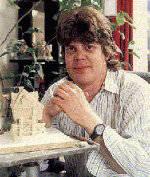
The Artist and His Cottages
| Browse Page in Full or Select a Category Header Below: |
|
John Hine's Overview About The Artist About The Collection What Cottages Are Made Of How Cottages Are Made The Collectors Guild |
Cover Notes From "Collecting David Winter Cottages"
by John Hines
 Many people have found enormous pleasure in making a collection of David Winter Cottages®,
those highly detailed miniature houses that are as British as afternoon tea
on the Vicarage lawn. The sculptor, David Winter, has a genuine feel for how people
lived years and years ago and how they built their own homes round their lives that
didn't have to conform to any rules and regulations, but suited their domestic activities
and needs. His attention to detail has become his hallmark and his work is instantly
recognizable due to the painstaking care he takes with every facet of each of his cottages.
The combination of natural artistry and dedicated craftsmanship has made David Winter Cottages®
a fine collectible which collectors appreciate and enjoy having in their homes.
Many people have found enormous pleasure in making a collection of David Winter Cottages®,
those highly detailed miniature houses that are as British as afternoon tea
on the Vicarage lawn. The sculptor, David Winter, has a genuine feel for how people
lived years and years ago and how they built their own homes round their lives that
didn't have to conform to any rules and regulations, but suited their domestic activities
and needs. His attention to detail has become his hallmark and his work is instantly
recognizable due to the painstaking care he takes with every facet of each of his cottages.
The combination of natural artistry and dedicated craftsmanship has made David Winter Cottages®
a fine collectible which collectors appreciate and enjoy having in their homes. |
About the Artist

|
Gifted English sculptor David Winter is regarded as one of the foremost creators of miniature
architectural structures. Born 1958 in Catterick, Yorkshire, David was inspired by his Mother, famed
British sculptor Faith Winter. It was in her studios that David inherited his creative skills.
Initially making pottery and decorative tiles, and then on a joint venture with
John Hine making heraldic shields. These were not successful but proved
useful in attracting David to design on a minute scale. He and John
experimented and in 1979 the first David Winter Cottage - 'The Mill House'
was produced. David's work found instant acceptability when they started to offer
them to selected shops in Great Britain and later in North America.
He has received worldwide acclaim. In 1988 the Company was awarded the Queens Award for Export. Each year an average of around 80 companies are selected, from 10 times as many, to receive the award. The recipients are entitled to fly the Queen's Award flag outside their premises and to use the emblem on stationery for a period of 5 years. Not to mention the prestige!
Other coveted awards from USA collectible associations during 1987 to 1989 include the following: |
|
 Inspiration for his models comes from a variety of sources; old books,
manuscripts, etchings and real buildings all play a part in the evolution
of an idea. But, the final shape and form of the sculpture comes firmly
from David's imagination.
Inspiration for his models comes from a variety of sources; old books,
manuscripts, etchings and real buildings all play a part in the evolution
of an idea. But, the final shape and form of the sculpture comes firmly
from David's imagination.
On a personal note, anyone who has met David (including me personally several times!!) will agree that he is a quiet, self-effacing man who is happiest out of the limelight. Building is one of his passions. It doesn't matter if it is a real life patio, chimmey,chimneye, kitchen, etc. This attention to design and no hesitation to do it again adds realism to his cottage sculptures. Travelling is David's biggest pet peeve. He does not like to drive, shop or deal with crowds. His mannerisms were both touching and uncomfortable when I saw him at rare collectible events. He was definitely more at ease when you met him away from the big crowds. His partner, John Hines, was more the "social butterfly" which made the twosome a great pair. The fact that David survived major tours that required an airplane flight, especially a transatlantic one, was a major feat in itself due to his nerve-racking fear of flying. |
About the Collection
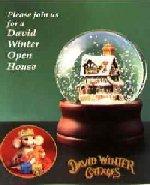 The David Winter Cottages® collection exists in homes around the
world because of two essential ingredients: David's enormous talent for
sculpting in the finest and most exquisite detail, and the ability of our
skilled craftspeople in Great Britain to make exact models from his originals.
The David Winter Cottages® collection takes us back to a tranquil
existence enjoyed by countless generations, who lived and worked in simpler
days gone by.
The David Winter Cottages® collection exists in homes around the
world because of two essential ingredients: David's enormous talent for
sculpting in the finest and most exquisite detail, and the ability of our
skilled craftspeople in Great Britain to make exact models from his originals.
The David Winter Cottages® collection takes us back to a tranquil
existence enjoyed by countless generations, who lived and worked in simpler
days gone by.
Each cottage demands outstanding skills from the craftsmen, casters and fettlers who need years of training to be able to produce the piece as David would wish to see it. This attention to detail has caused problems over time with meeting public demand without impacting the handmade quality. Each model comes with a Certificate of Authenticity containing a story card, which tells the tale of the occupants of that dwelling, or shares fascinating historical facts that are connected with the subject matter. In December 1993 John Hine Limited was sold in part to Media Arts Group Incorporated (MAGI), and later MAGI bought the remainder of the company. In 1997 after considerable upheval,upheaval have taken over the production and distribution of the cottages. All cottages' bearing the John Hine Studios label are now retired. |
What Cottages Are Made Of
 The cottages are made of crystacal, a form of natural gypsum which has a fascinating
history. 200 million years ago there were great inland seas and giant reptiles roamed
over the marshy swamp lands of Britain. Massive plants grew forty feet high and ferns
twelve feet high. It was hot and arid climate which eventually caused the seas to dry
up leaving large layers of gypsum which, like salt, comes from the evaporation of
large bodies of water. Later, the gypsum was covered by mud and sand, buried beneath
the land's surface while dinosaurs walked on top of it. During the millions of years
following, when the British Isles were being formed, the gypsum deposits were folded
and bent whilst land surfaces rose and fell and the earth's crust moved. Very large
earth movements led to the rocks being faulted with the gypsum being displaced and distorted.
The cottages are made of crystacal, a form of natural gypsum which has a fascinating
history. 200 million years ago there were great inland seas and giant reptiles roamed
over the marshy swamp lands of Britain. Massive plants grew forty feet high and ferns
twelve feet high. It was hot and arid climate which eventually caused the seas to dry
up leaving large layers of gypsum which, like salt, comes from the evaporation of
large bodies of water. Later, the gypsum was covered by mud and sand, buried beneath
the land's surface while dinosaurs walked on top of it. During the millions of years
following, when the British Isles were being formed, the gypsum deposits were folded
and bent whilst land surfaces rose and fell and the earth's crust moved. Very large
earth movements led to the rocks being faulted with the gypsum being displaced and distorted.
When the Ice Age came, the land surface was eroded or ground down, bringing the gypsum nearer the surface. These are the areas from which gypsum is quarried today.
The Egyptians were the first to use the gypsum to make small vessels and pots, and the word is derived from the Greek for "earth" and "cook". After the gypsum has been crushed it is then milled into a find powder and fed into an autoclave in which the rock is calcined in water at a high temperature and under pressure. Gypsum is then filtered, dried and ground to become crystacal. At no point in the process is anything added and in the workshops all they add is water to the crystacal powder before pouring it into the moulds. So, a David Winter Cottage® is made from an absolutely pure material which was formed two hundred million years ago. Hold in your hand a David Winter Cottage® and you are holding something older than the dinosaurs. |
How Cottages Are Made
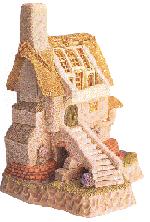 Let me first praise the unsung heroes -- those dedicated and devoted craftsmen
and craftswomen who have always responded to the completely unprecedented demands
of avid collectors. They not only work day and night to guarantee that every piece
ordered will be satisfactorily delivered, they also drive their craftsmanship to
exceptional heights of quality. These individuals make David Winter Cottages®
the preferred cottage collectible.
Let me first praise the unsung heroes -- those dedicated and devoted craftsmen
and craftswomen who have always responded to the completely unprecedented demands
of avid collectors. They not only work day and night to guarantee that every piece
ordered will be satisfactorily delivered, they also drive their craftsmanship to
exceptional heights of quality. These individuals make David Winter Cottages®
the preferred cottage collectible.
From the moment that David completes an original wax sculpture until the piece is ready for purchase in a shop, there is not a vestige of any form of equipment involved; everything, but everything is done exclusively by hand. Let me take you through the process as if you were a new wax original. First, the master mouldingmolding evaluates the sculpture and decides who has the skill to create the master gold reference mould that we will need to ensure the piece remains authentically the same throughout its life. The chosen master mould maker has the technique to be able to make a replica of David's original in a hard and durable material that will be a reference for ever. After the master moldmaker has finished, it is passed to the production moldmaking department to translate the work into moulds that reproduce David's original into the quantity that the collectors requires. This is also a highly developed skill and involves the most sophisticated disciplines. Once production moulds have been made, they are passed to casting. The production moulds are filled with liquid gypsum and "worked" to make them reveal all of the details without any air holes or blemishes. I had the opportunity to cast a cottage on my tour of Eggar's Hill in 1995. It was hard work to obtain a quality piece on even a simple small cottage like the Dower.
The finishers and packers also subscribe to the concept that only the best will do. From packing cottages go to dispatch and the team that makes up the order. Each order must be handled with extreme care, otherwise the receiving store receives a hotchpotch of bits of cottages that would interest a jig-saw enthusiast, but nobody else. |
The Collectors Guild
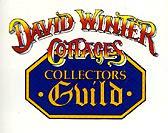 The Collectors Guild was started in 1986 and all who joined prior to December 31st 1997 became charter members.
A special membership piece is included in the yearly membership. The quarterly Guild magazine, Cottage Country,
is a full color 60 page publication that collectors praise as both
interesting and extremely well done. Guild members are invited to buy 2 pieces each year which are only available
to them. The special pieces are tightly controlled and a back-up system in the Guild Offices to ensure that the
principal of "one piece per Guild member" is not abused. The Guild will continue to be operated by Enesco.
The Collectors Guild was started in 1986 and all who joined prior to December 31st 1997 became charter members.
A special membership piece is included in the yearly membership. The quarterly Guild magazine, Cottage Country,
is a full color 60 page publication that collectors praise as both
interesting and extremely well done. Guild members are invited to buy 2 pieces each year which are only available
to them. The special pieces are tightly controlled and a back-up system in the Guild Offices to ensure that the
principal of "one piece per Guild member" is not abused. The Guild will continue to be operated by Enesco.
|
Acknowledgement:
Much of the information for this page came from three main sources:
"Collecting David Winter Cottages" by John Hines
"Cottage Country" magazine issues
Personal knowledge from 12 years of collecting David Winter Cottages
This page was created by Wanda Tooker, with her permission it is available here.
I would like to thank her for making it available to all the DW collectors. I hope
this information is useful to all collectors. Please also visit Wanda's site at
http://www.flash.net/~txtooker
This page has been visited
Last updated 7/24/99.
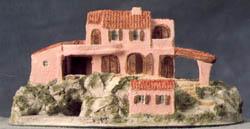 Production began in the coal shed at the foot of David's parents' house.
John Hine did the talking and selling. Initial cottage such as the Provincial One pictured to the right were more rudimentary than
current market cottages. As David, and associated craftsmen and craftswomen's skills increased over
time, so did the popularity of the cottages. In 1981 larger premises were found at Borden, and then later
to Eggars Hill.
Production began in the coal shed at the foot of David's parents' house.
John Hine did the talking and selling. Initial cottage such as the Provincial One pictured to the right were more rudimentary than
current market cottages. As David, and associated craftsmen and craftswomen's skills increased over
time, so did the popularity of the cottages. In 1981 larger premises were found at Borden, and then later
to Eggars Hill.
 There are many grades of gypsum and unfortunately the pure, white top quality gypsum (from which
the crystacal is made) comes from the very bottom of the quarry, underneath several seams of
inferior quality gypsum. Under the subsoil is the third grade quality gypsum which is used
in the building of industry and then one has to dig down a further hundred feet through layers
called thumblers and grey rock, cakes and top rock and riders until at about a hundred and
sixty feet one comes across the best, pure white gypsum in a very narrow seam. This is hacked
out of the quarry and taken in large lumps to be crushed mechanically into small pebbles.
There are many grades of gypsum and unfortunately the pure, white top quality gypsum (from which
the crystacal is made) comes from the very bottom of the quarry, underneath several seams of
inferior quality gypsum. Under the subsoil is the third grade quality gypsum which is used
in the building of industry and then one has to dig down a further hundred feet through layers
called thumblers and grey rock, cakes and top rock and riders until at about a hundred and
sixty feet one comes across the best, pure white gypsum in a very narrow seam. This is hacked
out of the quarry and taken in large lumps to be crushed mechanically into small pebbles.
 The harden, unadulterated, pure white gypsum cottages are then passed to the homepainters. Years ago John Hines
Studios decided that painting at home was more effective than trying to paint the pieces in an organized environment
because the pride of the home artist who painted the piece is everything. This facet makes each cottage unique as each
artist as their own personal touch to each piece. Painted cottages are sent to quality control who won't let a single
piece that is less than perfect pass through the system. Visitors to the Workshops are always appalled at the way they
merrily destroy a desperately needed piece because it is not up to standard.
The harden, unadulterated, pure white gypsum cottages are then passed to the homepainters. Years ago John Hines
Studios decided that painting at home was more effective than trying to paint the pieces in an organized environment
because the pride of the home artist who painted the piece is everything. This facet makes each cottage unique as each
artist as their own personal touch to each piece. Painted cottages are sent to quality control who won't let a single
piece that is less than perfect pass through the system. Visitors to the Workshops are always appalled at the way they
merrily destroy a desperately needed piece because it is not up to standard.